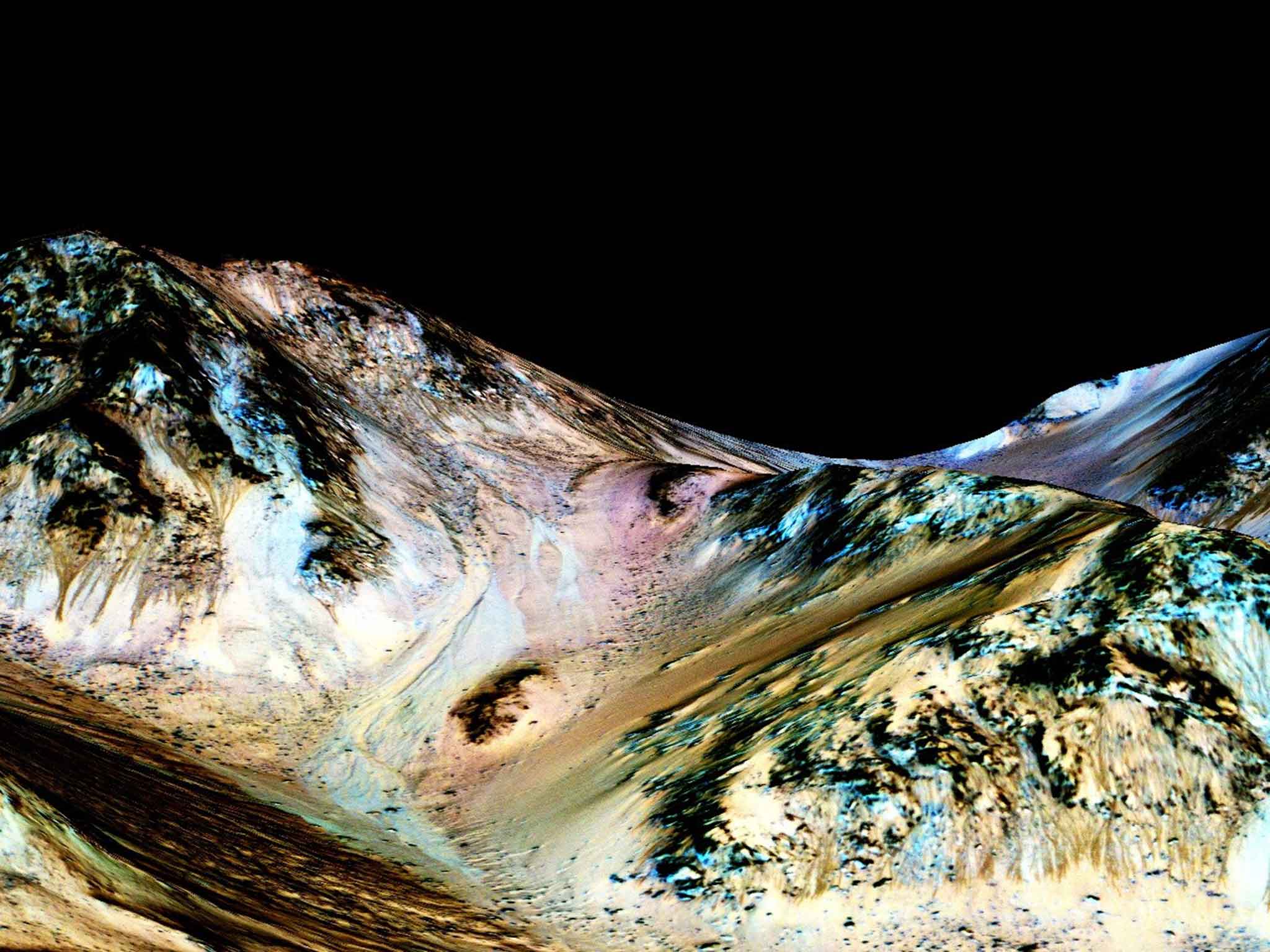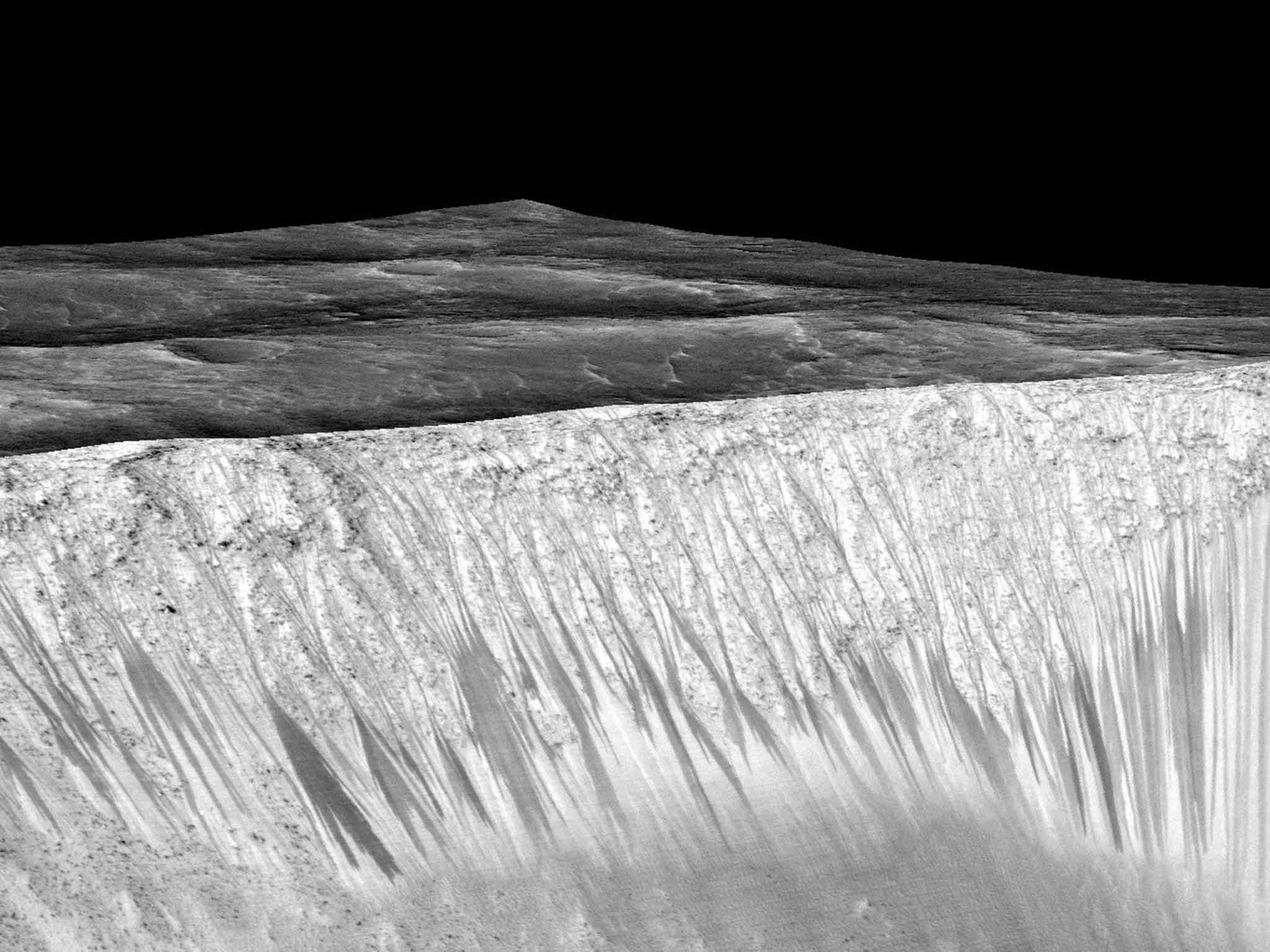Hydrated salts: How Nasa discovered flowing water on Mars – and what it means
- New images confirm presence of 'hydrated salts' in gullies running down Martian mountains
- But there is as yet no suggestion that Nasa is close to finding signs of lifeforms on the planet

Streaks of salty water flow down the mountains and canyons of Mars during summer seasons, raising the odds that life may one day be found on the Red Planet, Nasa scientists have announced.
An analysis of the dark patches that ebb and flow on the slopes of Mars shows that they contain “hydrated” salt crystals containing molecules of water – the first time scientists have directly detected liquid water on Mars.
Images taken from a spectroscopic instrument on board the Mars Reconnaissance Orbiter flying around the planet have confirmed the presence of briny water in the dark formations running periodically down the Martian slopes, which Nasa first detected in 2000.
Last April, Nasa’s Curiosity rover detected the presence of salts that could absorb water vapour in the Martian atmosphere, but now the Mars orbiter has found unambiguous signs that liquid water does indeed form around the salt crystals present in the dark streaks of the Martian hillsides.

“The detection of hydrated salts on these slopes means that water plays a vital role in the formation of these streaks,” said Lujendra Ojha, of the Georgia Institute of Technology in Atlanta, the lead author of a study published in the journal Nature Geoscience. “This is the first spectral detection that unambiguously supports our liquid-water-formation hypotheses,” Mr Ojha added.
Liquid water is considered an essential ingredient for life, which is made more tangible by the presence of dissolved salts, which are also vital for the survival of living organisms, scientists said. However, there is as yet no suggestion that Nasa is even close to finding signs of simple microbial life forms on Mars, where the surface is constantly bombarded by life-destroying cosmic radiation, and experiences wide temperature extremes.
“Our quest on Mars has been to ‘follow the water’, in our search for life in the universe, and now we have convincing science that validates what we’ve long suspected. This is a significant development, as it appears to confirm that water – albeit briny – is flowing today on the surface of Mars,” said John Grunsfeld, an associate administrator of Nasa’s Science Mission Directorate in Washington.

Over the past 15 years, Nasa has several times announced evidence to suggest that water exists or once existed on Mars. In 2000, it said it had discovered water-eroded gullies running down Martian slopes, and this year it said it had found salts on the Martian surface that could absorb water vapour from the atmosphere.
Now, the Mars orbiter has gathered spectroscopic data from these dark streaks that shows the presence of briny water containing the salts magnesium perchlorate, magnesium chlorate and sodium perchlorate. The researchers said that microbial life forms on Earth can live in such briny solutions whenever they appear on Earth, such as in the dry Atacama Desert of Chile.
Dr Grunsfeld, a former astronaut, said that finding water and perchlorate salts on Mars could help to support future manned missions to the Red Planet as the water could be used for drinking and making oxygen, and the perchlorates could be made into solid rocket fuel. “Mars has resources that are useful for the future. Water is crucial because we need it to drink, and we need oxygen to breathe,” he said.
“We’ll be sending humans in future to Mars. They will be looking for signs of life, and the resources they need will be there,” he said.
Joe Michalski, a Mars researcher at the Natural History Museum in London, who was not involved in the research, said: “These results provide strong evidence that salty water occasionally flows on the Martian surface. We know from the study of extremophiles on Earth that life can not only survive, but thrive in conditions that are hyperarid, very saline or otherwise ‘extreme’ in comparison to what is habitable to a human.”
He added: “In fact, on Earth, wherever we find water, we find life. That is why the discovery of water on Mars over the last 20 years is so exciting.”
Join our commenting forum
Join thought-provoking conversations, follow other Independent readers and see their replies
Comments
Bookmark popover
Removed from bookmarks